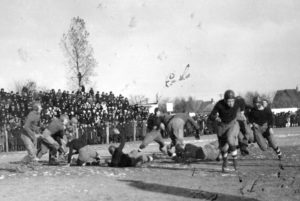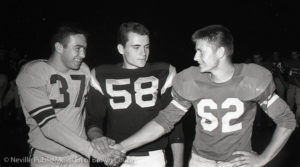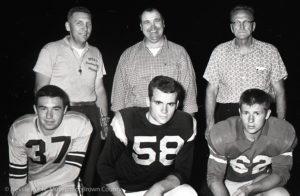By Rich Palzewic
Correspondent
GREEN BAY – When the Green Bay East and West high school football teams take the field for their 117th meeting Friday, Sept. 30, it will mark the continuation of one of the oldest and most storied high school football rivalries in Wisconsin.
And when you throw in the names of the legendary players who have taken part, local football historian Cliff Christl said it could be one of the greatest high school rivalries in the country.

“For a long time, the rivalry was the biggest football game in the city,” Christl said. “In the 1920s, at least twice, it outdrew the Packers-Bears game. In the early 1950s, as I recall, the game was still drawing up to 15,000 fans. Not only was it the biggest football game in the city, but it was also the biggest event in the city for probably more than 30 years.”
East currently leads the series overall, 63-50-3.
“It’s been a bitter rivalry,” said Christl, a 1965 East graduate. “I grew up in the 50s, so I’m fully aware of how intense it was. When I was growing up, if you were from the East side, lots of people wouldn’t drive to the West side, and vice versa. Maybe it wasn’t true hate, but it was a great dislike.”
First meeting
The schools officially met for the first time on Nov. 30, 1905.
East won that game 21-0.
“It wasn’t until six days before the game the schools ironed out their differences and agreed to play,” Christl said. “The first game was played at Hagemeister Park, roughly in the area where East High now stands. The first game also established another tradition that would begin the next year and be upheld for more than two decades – playing on Thanksgiving Day.”

The days of riots
Christl said there were riots associated with the game in the early years.
“Public officials were reluctant to call it that, but there were fights on the bridges (over the Fox River). Police had to block the bridges, fires were set in the downtown area and City Hall and the police station were stoned,” he said.
The days leading up to the 1942 game might have been the most contentious, Christl said.
“On the eve of the game, close to 500 students blocked streets, started bonfires, smashed bottles and marched into stores, stealing and destroying property. It took nearly three hours and streams of water sprayed from a fire truck to finally disperse the crowd.”
Six years later, following the 1948 game, another riot erupted in downtown Green Bay.
“A mob of both students and non-students rocked buses, damaged property and vandalized cars,” Christl said. “At least 19 young people were arrested. The future of the rivalry was in doubt.”
Another riot followed the 1954 game.

“A mob of about 350 from both sides of the river injured a 16-year-old girl, knocked a policeman to his knees and damaged cars, buildings and traffic signs,” Christl said. “Twenty-two people were arrested. The next 25 East-West games were played on Saturday afternoon.”
The rivalry of old
Christl said if there’s one football game he would have liked to attend in the years before he was born, it would have been an East-West game.
“Can you imagine seeing Curly Lambeau during his senior year (at East), watching (East head coach) Tom Hearden on the sidelines, seeing (East’s) Jim Crowley — one of the four Horseman at Notre Dame — play? Or West quarterback Arnie Herber throwing passes?” he said.
Many players from the earlier days of the rivalry went on to play in the National Football League – mostly for the Packers in their formative years in the 1920s and ‘30s.
Two future Pro Football Hall of Famers played in the East-West rivalry: West’s Arnie Herber, who was inducted as a Packers quarterack, and East’s Lambeau, who was inducted as a Packers coach.
The rivalry struggles today
Christl still attends the game some years and said there are maybe 1,000 fans in attendance.
“The age of television, minor league baseball, additional schools, more options for sports and open enrollment have certainly hurt East and West,” he said. “The rivalry is entirely different today. It was such a special thing – not only in terms of what it meant to Green Bay, but the passion it fueled and the interest it created.”
With both schools struggling to field competitive teams for the past several years, Christl said it’s not unlike many city high schools across the state.
“It’s not only happening in Green Bay – it’s happening all over,” he said. “With a few exceptions, very few urban high schools have the programs they once did – Madison, Milwaukee, Eau Claire, etc. I’m not sure that will ever change.”
Christl said Superior in far northwest Wisconsin is a classic example.
“There’s probably no other city in the state that had as rich a history in football as Superior,” he said.
“They had Ernie Nevers, Bud Grant and Tuffy Leemans – three people in the Pro Football Hall of Fame. Superior hasn’t had the program they once had for many years.”
East-West fast facts
• The last East-West game played at Lambeau Field was in 1977.
• The 1918 game was canceled three different times due to an influenza epidemic. It was finally played Dec. 7, 1918.
• The largest crowd to ever witness the game came Oct. 30, 1953, when 15,071 spectators attended.
• The first night game was played Nov. 6, 1936.
• Austin Straubel (Austin Straubel Airport) started for East. He graduated in 1923.
• East and West shared the conference title in 1931, 1932, 1939 and 1941.
• From 1905-27, East was known as the “Hilltoppers.” They became the “Red Devils” in 1928.
• West became the “Wildcats” in 1932. Before this, they were known as the “Purple Eleven.”
• East and West first met Sept. 21, 1895, and played to an 8-8 tie, but the game wasn’t recorded as an official contest. East had eight players, while West had 10.
• Of the 116 games played, 14 took place at Lambeau Field.
• West’s longest winning streak in the series is seven – from 1909 to 1915.
• East’s longest winning streak in the series is 11 – from 1998 to 2008.
• East’s 70-0 victory in 2018 is the largest margin of victory.
• East has won 18 of the last 21 games in the series.
• Head coach Tom Hearden, who starred at East in the early 1920s, took over the programm in 1935. At one point, East won 32 straight games overall under Hearden’s leadership. He finished with a 51-3-2 record at East.
• The 1930 game – a 2-0 victory for East – was the last played on Thanksgiving Day.
